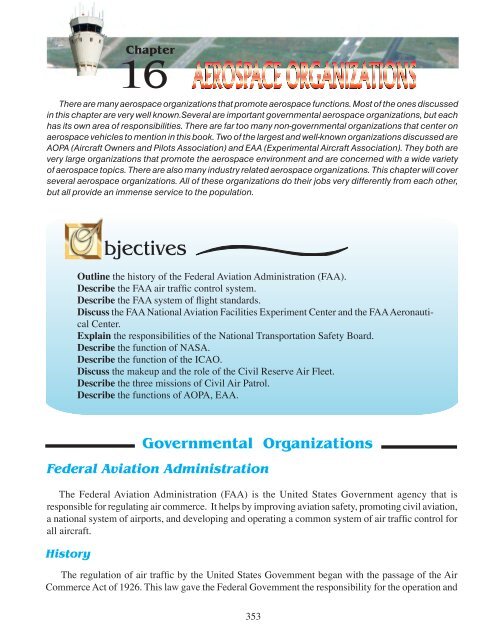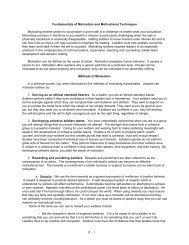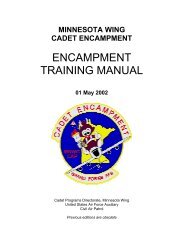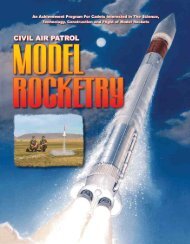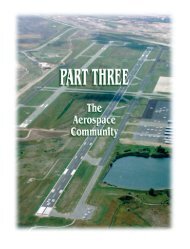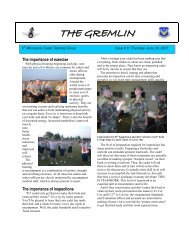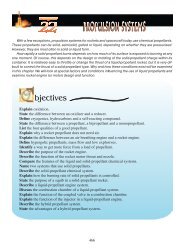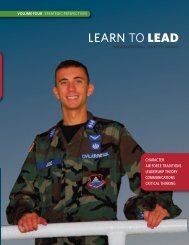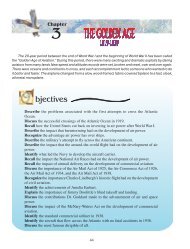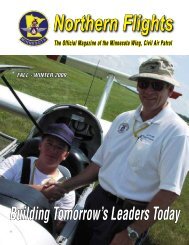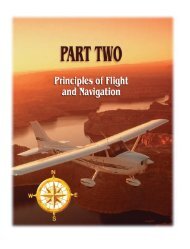Chapter 16 - Aerospace Organizations - Civil Air Patrol
Chapter 16 - Aerospace Organizations - Civil Air Patrol
Chapter 16 - Aerospace Organizations - Civil Air Patrol
You also want an ePaper? Increase the reach of your titles
YUMPU automatically turns print PDFs into web optimized ePapers that Google loves.
maintenance of the airway system over the United States, including all aids to air navigation. It alsoauthorized the Department of Commerce to develop a system of regulations, which would provide safetyin air commerce. The Bureau of <strong>Air</strong> Commerce was established within the Department of Commerceto carry out these programs.The first safety regulations developed were the requirementsfor registration and licensing of aircraft, and the certification andmedical examination of all pilots. The Bureau of <strong>Air</strong> Commercedid much to improve aviation radio and other navigational aids.It also promoted airport construction throughout the country, butit did not provide financial assistance for building airports.<strong>Civil</strong> Aeronautics Act - 1938. By 1938, the carrying ofairmail and passengers had increased significantly, making newlegislation necessary. The new law governing civil aviation wascalled the <strong>Civil</strong> Aeronautics Act of 1938. This act placed all airtransportation regulations, both economic and safety, under threeseparate agencies. The first was the <strong>Civil</strong> Aeronautics Authority, which established policies governing thesafety and economics of air transportation. The second was the Office of the Administrator of Aviation,which was formed to carry out the safety policies of the <strong>Civil</strong> Aeronautics Authority. The third was the<strong>Air</strong> Safety Board, which was formed to investigate aircraft accidents.In 1940, the <strong>Civil</strong> Aeronautics Act was amended, and the three agencies were reduced to two. The<strong>Civil</strong> Aeronautics Board (CAB) took over the policy-making responsibility in both safety and economicmatters. It also assumed the accident investigation duties of the <strong>Air</strong> Safety Board. The second agencywas the <strong>Civil</strong> Aeronautics Administration (CAA). It was charged with executing the safety regulationsdeveloped by the CAB and with operation of the airway system. The CAA was placed under theDepartment of Commerce.Federal <strong>Air</strong>port Act - 1946. The Federal <strong>Air</strong>port Act of 1946 provided for the CAA to design asystem of airports throughout the United States using federal funds for their development. This legislationwas needed because of the tremendous increase in aviation activity after World War II. The Federal<strong>Air</strong>port Act of 1946 was amended several times, but it remained in effect until the <strong>Air</strong>port and <strong>Air</strong>wayDevelopment Act of 1970 was passed in June 1970.Federal Aviation Act - 1958. The <strong>Civil</strong> Aeronautics Act remained in effect for 20 years (1938- 1958) before the regulation of civil aviation was again changed by the Federal Aviation Act of 1958.The biggest change provided by this act was that the CAA, which was part of the Department of Commerce,became an independent agency—the Federal Aviation Agency (FAA). The Federal AviationAct of 1958 removed the responsibility for developing safety regulations from the CAB and gavethis responsibility to the newly formed FAA. In effect, this gave the FAA the responsibility for bothdeveloping safety regulations and enforcing them. The CAB retained its responsibility for economicregulation of air commerce and the investigation of aircraft accidents.Department of Transportation Act - 1966. The final change in the status of the FAA came withthe Department of Transportation Act, passed in 1966. This act placed all public transportation under asingle manager, the Department of Transportation. The duties and responsibilities of the FAA remainedunchanged, but the name was changed to the Federal Aviation Administration. During its history, the354
<strong>Chapter</strong> <strong>16</strong> - <strong>Aerospace</strong> <strong>Organizations</strong>present-day FAA has been called the Bureau of <strong>Air</strong> Commerce, the Administration of Aviation, the<strong>Civil</strong> Aviation Administration and the Federal Aviation Agency.Duties and Responsibilities<strong>Air</strong> Traffic Control. One of the FAA’s biggest tasks in the area of aviation safety is the control ofair traffic. <strong>Air</strong> traffic control is concerned with keeping aircraft safely separated to prevent accidents.This is necessary while aircraft are taxiing, taking off, climbing, en route, and approaching and landing.The FAA also provides preflight and in-flight services to all pilots for air traffic control and safetypurposes.<strong>Air</strong> traffic control is accomplished by establishing certain parts of the airspace as controlled airspaceand by requiring that all aircraft flying within this controlled airspace follow certain rules and regulations.There are two types of facilities that control the Instrument Flight Rules (IFR) traffic flying within thecontrolled airspace. The first type is the <strong>Air</strong>port Traffic Control Tower, which controls traffic departingor arriving at certain airports. The control tower is equipped with complex electronic equipment andis operated by highly skilled FAA air traffic controllers. The tower also controls aircraft taxiing on theground. As would be expected, the busier the airport and the more types of aircraft it handles, the morerestrictive are the rules and regulations. Certain large metropolitan airports require all aircraft usingthe facility to be equipped with various types of traffic control equipment. Some of this equipment isBased on the volume of aircraft traffic handled, the Flight Service Station provides by far themost service, including in-flight information and assistance in the event a pilot becomes lostor is having trouble. Pictured here is the FAA Flight Service Station in Denver, Colorado.355
very expensive, and many general aviation pilots cannot afford it. They are restricted from using theselarge airports.After the IFR aircraft leaves the immediate area of the airport, the controller in the tower will “handit off” (transfer it) to another air traffic controller in the second type of facility known as the <strong>Air</strong> RouteTraffic Control Center (ARTCC). The ARTCC assigns the aircraft a certain altitude and a specific routeto follow to its destination. The pilot must not change the route or the altitude without permission. Asthe flight continues, the aircraft is transferred from one ARTCC to another. The flight is under positivecontrol at all times, and no other aircraft is allowed to enter that aircraft’s “piece of airspace.” TheARTCCs follow the flight on radars and are in voice communications at all times. Commercial airliners,general aviation, and military aircraft all use the same traffic control system when flying withinthe controlled airspace using IFR.The FAA also provides assistance to pilots who do not fly within the controlled airspace. Theseare mostly general aviation pilots since most airline and military aircraft are required to fly IFR at alltimes. This assistance is provided by the Flight Service Station (FSS). The FAA personnel who workin the FSSs provide preflight informationsuch as weather information,suggested routes, altitudes, etc., topilots. In addition, the FSS providesin-flight information, via radio,and assistance in the event a pilotbecomes lost or is having trouble.Based on the volume of aircrafttraffic handled, the FSS providesby far the most service. This is notsurprising since they handle mostlygeneral aviation traffic, which includesover 90 percent of all pilotsand aircraft.The control towers, centers,and flight service stationsare all connected andwork closely togetherto keep a safe and orderlyflow of traffic.The system is currentlyvery heavily loaded. TheFAA is modernizing and updatingall of its equipment to handlethe increase in traffic.<strong>Air</strong>way Facilities. The nation’s airways are a 250,000-mile system of highways in the sky which<strong>Air</strong> Route Traffic Control CenterShowing Radar Console with Controllerpilots follow from takeoff to landing. Currently, the heart of the system is the Very High FrequencyOmni-Directional Range (VOR) system, which covers the United States. These VORs are used for356
<strong>Chapter</strong> <strong>16</strong> - <strong>Aerospace</strong> <strong>Organizations</strong>navigation along the airways. The FAA is responsible for operation and maintenance of these facilities.They also own and maintain other radars, instrument landing systems and communications at the variousairports. These facilities are checked regularly by specially instrumented FAA aircraft.Flight Standards. The FAA is responsible for ensuring that all pilots and aircraft are safe throughenforcement of a system of flight standards. These standards ensure that all aircraft are airworthy, allairmen (pilots, navigators, air traffic controllers, engineers, mechanics, etc.) are competent and allregulations and procedures are followed.All new models of aircraft, engines, instruments or other components must meet very rigid safetystandards before the FAA certifies them. When a manufacturer brings out a new aircraft, the FAAworks with the engineers and designers during construction of the prototype. It is then thoroughlyground-tested and flight-tested before being given a type certificate. This certificate confirms that thistype of aircraft has met FAA standards of construction and performance. A production certificate islater provided, which shows that the manufacturer can duplicate the aircraft that was type certificated.The production certificate allows the manufacturer to continue to produce that type of aircraft. As eachproduction aircraft is built, it must be issued an airworthiness certificate, which ensures that it has beentested and is safe for use.Even after an aircraft starts flying, the FAA continues to check its safety. They control aircraftmaintenance programs by setting times for inspection and overhaul. The FAA also certifies the repairand overhaul facilities to ensure that the aircraft receives proper maintenance and repair.Before flying an aircraft, a pilot must have a FAA-issued pilot certificate. There are many typesof certificates, but in all cases, they certify that the holder has passed medical examinations. The FAAalso requires that a physical examination and a flight-check ride with a flight instructor be completedevery 2 years.Research and Development. The National Aviation Facilities Experiment Center (NAFEC) is theFAA’s research and development center. This center, located in Atlantic City, New Jersey, is involved inresearch to upgrade our airway systems, to improve aircraft instruments and systems, and to reduce theworkload on the pilot in the aircraft and the controller on the ground. All of these efforts are expendedto make flying easier and safer.The NAFEC is currently working on new types of airway navigational systems, which willreduce the congestion of our airways in the future. Another area, which they are working on, is newinstrument landing systems which would allow aircraft to land safely in any type of weather regardlessof visibility.They are also involved in research on collision avoidance systems for use in aircraft. This wouldprovide a warning to both pilots any time two aircraft were on a course that would lead to a collision.The system would also tell the pilots the type of evasive action to take to avoid a collision.Aeronautical Center. Another facility operated by FAA is the Aeronautical Center in OklahomaCity, Oklahoma. This multi-million dollar facility is the home of the FAA Academy, which is the trainingcenter for FAA operational personnel. They train the personnel who operate the ARTCCs, FSSs andairport control towers. In addition to training FAA control tower operators, they also train controllers forthe military and for many foreign countries. The academy is also the training ground for the engineersand technicians who install and maintain the electronic equipment used for navigation, communicationsand air traffic control. Finally, the academy also provides initial and refresher training for their357
<strong>Chapter</strong> <strong>16</strong> - <strong>Aerospace</strong> <strong>Organizations</strong>are available to assist in determining the causes of various accidents. They also assist the manufacturersin making their aircraft safer.The result of these agencies working together to promote aviation safety is an air transportationsystem that is safer than any other form of public transportation.National Aeronautics andSpace AdministrationThe National Aeronautics and Space Administration (NASA) is a government organization thatis very well known throughout the world. Most everyone thinks space exploration when they thinkNASA. It is much more than just space. You will be learning a great deal about NASA in the followingchapters about space; mostly about the spacecraft and not the organization itself.NASA’s budget is under one percent of the federal budget, or over $13 billion, and is divided intofour strategic enterprises. They are Science, Aeronautics, Space Operations, and Human Explorationand Development of Space. To support these strategic enterprises, NASA employs 18,500 civilservants and is divided into nine field centers, thecontractor-operated Jet Propulsion Laboratory andthe Wallops Flight Facility. Each of these facilitiesdirectly supports one or more of the strategicenterprises.NASA’s mission statement is threefold andis directly supported by the strategic enterprises.The first part is to explore, use and enable thedevelopment of space for human enterprise. Thesecond part is to advance scientific knowledge andunderstanding of the earth, the solar system andthe universe and use the environment of space forresearch. The third part is to research, develop,verify and transfer advanced aeronautics, spaceand related technologies. NASA contributes agreat deal to the goals of the United States and theworld. It promotes economic growth and securityto America by conducting aeronautics, and spaceresearch and development in partnership withindustry, academia and other federal agencies tokeep America capable and competitive. It helps topreserve the environment through studies of earth asa planet and a system, enabling the world to addressenvironmental issues. It engages the educationalAmerica leads the world in aerospace technology. (EAA)world by directly supporting and encouraging359
learning through its many educational endeavors. It also promotes world peace through the explorationand discovery of the universe for all mankind.NASA research has many great spin-offs of technology to our society. Our space program did notdirectly develop such things as solid-state televisions, pocket calculators or microwave ovens, but theseitems and thousands more are spin-offs of aerospace technology. Other things we can list are glassesthat darken as the light becomes brighter, digital watches and tiny nickel cadmium (NiCad) batteries.Small hearing aids in the bow of your glasses and artificial pacemakers for heart patients are also spinoffsof aerospace technology.In the area of materials, we have new temperature-resistant metals, extra strong plastics, bondedlubricants, super insulators and composite materials, which were developed for our space effort. Theseare now being used in aircraft, automobiles, sporting goods, houses, etc. How do you judge the valueof these spin-off products? The answer will vary for each individual. If you are one of the more than2,000,000 people being kept alive by an artificial heart pacemaker, your answer will probably be thatit is very valuable.International <strong>Civil</strong> AviationOrganization (ICAO)The ICAO is an international organization dedicated to standardizing aviation functions. Originallystarted on December 7, 1944, it was completely ratified by the member countries on April 4, 1947.Later that year, it became a special agency of the United Nations linked to the Economic and SocialCouncil. Today, almost all nations of the world follow the ICAO rules.The primary ICAO activity is standardization. It provides a means and forum for countries tostandardize the many activities associated with aviation. Some of the subject areas standardized arerules of the air, aeronautical meteorology, aeronautical charts and symbols, air traffic services, searchand rescue, aeronautical information services, airspace designations, airports and even language. Theuniversal aviation language is English. All pilots and controllers in foreign countries must be able tospeak and understand English to use the ICAO system. These standards are constantly reviewed forchanges as technology changes aviation. The overall goal of the ICAO is to make the skies safer andmore prosperous for all aircraft. Without these standards in place, international air travel would bevery close to impossible. The ICAO has made air travel a much safer and easier place in which tooperate.<strong>Civil</strong> Reserve <strong>Air</strong> FleetThe <strong>Civil</strong> Reserve <strong>Air</strong> Fleet (CRAF) is composed of commercial airliners, which have beendesignated by the Department of Defense for use in time of national emergency. These aircraft are longrangejet transports, which have been specially equipped so they can be quickly converted for militaryuse. The CRAF is subject to call on a 24-hour notice. However, the CRAF is more than just aircraft, italso includes aircrews and maintenance crews supplied by the airlines.360
<strong>Chapter</strong> <strong>16</strong> - <strong>Aerospace</strong> <strong>Organizations</strong>When activated, the CRAF would provide the armed forces with modern, fast aircraft capable ofairlifting troops and supplies to any point on the earth’s surface. The capability of the CRAF continuesto expand as more of the newer and larger jumbo jets are added to airline service.The CRAF was established to assist the military in case of a national emergency, but it is alsoavailable for use in case of a natural disaster. In this case, only a small portion of the CRAF would beactivated to provide airlift assistance to earthquake, flood or drought victims.<strong>Civil</strong> <strong>Air</strong> <strong>Patrol</strong>National Headquarters <strong>Civil</strong> <strong>Air</strong> <strong>Patrol</strong>, Maxwell <strong>Air</strong> Force Base, AlabamaThe <strong>Civil</strong> <strong>Air</strong> <strong>Patrol</strong> (CAP) is a federally chartered, private, nonprofit corporation and is also theofficial civilian auxiliary of the United States <strong>Air</strong> Force. The over 60,000 volunteer members areaerospace-minded citizens dedicated to service for their fellow Americans. CAP has three basic missions—emergencyservices, aerospace education, and cadet programs.Emergency Services. CAP uses more than 580 corporate-owned and 4,400 member-furnished aircraftto fly various emergency missions. These include search and rescue (SAR) missions for downed aircraft,lost hunters, fishermen, children, etc.; disaster relief missions for natural disaster; and, emergency airliftmissions of sick or injured persons, as well as transporting blood and body organs.<strong>Aerospace</strong> Education. CAP conducts an aerospace education program for its membership andfor the general public. This program develops an awareness and appreciation of the aerospace world361
in which we live. CAP’s involvementin aerospace education includessponsorship of workshops for teachers,and development of curriculum andother materials to help teach aerospaceeducation to all grade levels.CAP Emergency Services<strong>Aerospace</strong> Education in All GradesCadet Programs. CAP cadets are young men and women, ages 12 to 21, who are interested inaerospace and in community service. The cadet program is structured to use aerospace as a vehicleto help teach leadership and management skills, moral leadership and physical fitness. The programemphasizes activities and involvement of the cadets.CAP was founded in 1941, and for 60 years, the CAP members have been involved in service totheir communities and their nation.CAP Cadetsexperienceflight.362
<strong>Chapter</strong> <strong>16</strong> - <strong>Aerospace</strong> <strong>Organizations</strong>Nongovernmental <strong>Organizations</strong><strong>Air</strong>craft Owners and Pilots Association (AOPA)AOPA was founded in 1939 to support the views and rights of aircraft owners and pilots. Ithas continuously built on this premise. Today, it is the leading voice among aircraft owners andpilots to Congress and the FAA. It continuously monitors the government very carefully and, inpartnership with the government, strives to make the skies safer for all who use it. One of the mostrenowned suborganizations within AOPA is the <strong>Air</strong> Safety Foundation.Founded in 1950, the <strong>Air</strong> Safety Foundation is the nation’s largest organization dedicatedto providing aviation education and safety programs for general aviation. It accomplishes thisthrough researching accidents, distributing safety related materials to pilots, conducting trainingand providing free public-service aviation safety seminars.Experimental <strong>Air</strong>craft Association (EAA)One of the fastest growing areas of aviation is the homebuilt market. The EAA was formedto help builders to safely construct and fly their aircraft. It is one of the largest general aviationorganizations, along with AOPA. Its local chapters provide builder training and education. EAAsupports all sport aviation including antique aircraft, warbirds and ultralights. It also works withthe government to ensure the voice of general aviation is heard and understood. Each year, itEAA Headquarters, Oshkosh, Wisconsin (EAA)363
<strong>Chapter</strong> <strong>16</strong> - <strong>Aerospace</strong> <strong>Organizations</strong>industries. This means that the areas they work in are involved in the most modern, up-to-date areasof applied research. Because of the highly technical nature of the work in the aerospace industries, thepersonnel tend to be very skilled and more highly trained than in the average manufacturing industry.This is true for production workers, managers, scientists and engineers. As a result, salaries generallyaverage higher in the aerospace industries.• Federal Aviation Administration (FAA)• <strong>Air</strong> Commerce Act of 1926• <strong>Civil</strong> Aeronautics Act (1938)• <strong>Civil</strong> Aeronautics Board (CAB)• <strong>Civil</strong> Aeronautics Administration (CAA)• Federal <strong>Air</strong>port Act of 1946• Federal Aviation Act of 1958• <strong>Air</strong> Traffic Control• Instrument Flight Rules (IFR)• <strong>Air</strong> Route Traffic Control Center (ARTCC)• Flight Service Station (FSS)• National Aviation Facilities Experiment Center(NAFEC)• <strong>Civil</strong> Aeromedical Institute (CAI)• National Traffic Safety Board (NTSB)• Bureau of Aviation Safety• National Aeronautics and Space Administration(NASA)• International <strong>Civil</strong> Aviation Organization (ICAO)• <strong>Civil</strong> Reserve <strong>Air</strong> Fleet (CRAF)• <strong>Civil</strong> <strong>Air</strong> <strong>Patrol</strong> (CAP)• <strong>Air</strong>craft Owners and Pilots Association (AOPA)• Experimental <strong>Air</strong>craft Association (EAA)• <strong>Aerospace</strong> Industries Association (AIA)• General Aviation Manufacturers Association (GAMA)365
SELECT THE CORRECT ANSWER1. The (FAA / CAB) has responsibility for economic regulation of air commerce and the investigationof aircraft accidents.2. The (FSS / IFR) provide preflight information such as weather, suggested routes, and altitudes topilots.3. The (NAFEC / Bureau of Aviation Safety) conducts research to upgrade the airway system,improve aircraft instrumentation, and reduce the workload on pilots and controllers.4. The (NTSB / FAA Aeronautical Center) investigates all transportation accidents.5. (NASA / NAFEC) controls the contractor operated Jet Propulsion Laboratory and the WallopsFlight Facility.6. (IFR / ICAO) is a special agency of the UN linked to the Economic and Social Council.FILL IN THE BLANKS7. The ________________________ (FAA) was created as an ____________ ________ by thethe Federal Aviation Act in 1958. It replaced the _____________ _____________ _________(CAA), which had been under the Department of _________________. As such, the FAA wasnow tasked with both developing ___________ ____________ and _________________ them.In 1966, the name was changed to __________ ____________ __________ (still abbreviatedFAA) and they were placed under the Department of ____________________, with all otherpublic transportation.8. ________ ________ _______ ________ controls the aircraft while on the ground and duringtakeoffs and landings. After takeoff, they are handed off to _________ __________ _________________ ________, who assigns a specific route and altitude to fly. The flight is under__________ ___________ at all times, as the aircraft is passed from one sector to another. Asthe aircraft approaches its destination, it is again handed off to the __________ ____________for its arrival instructions.9. FAA flight standards ensure that all ______________ are airworthy by being type certified, andthat all ______________ meet competency requirements through checkrides and evaluations.10. _________________ is the universal language of aviation.11. The ____________ _________ ______________ _____________ is the international organizationdedicated to standardizing aviation functions.12. _________________________ was founded in 1939 to support the views and rights of its members,and as their voice to Congress and the FAA.13. The ____________ ________ _________, one of the largest general aviation organizations,was formed to help builders safely construct and fly their aircraft.366
<strong>Chapter</strong> <strong>16</strong> - <strong>Aerospace</strong> <strong>Organizations</strong>TRUE OR FALSE14. The FAA currently falls under the Department of the Interior.15. NASA research has provided many great spin-off technologies to our society.<strong>16</strong>. The heart of the airways system in the United States is the Very High Frequency Omni-DirectionalRange system, which covers the country.17. CRAF only applies to aircraft, not crews or maintenance personnel.18. The <strong>Civil</strong> <strong>Air</strong> <strong>Patrol</strong> is federally funded, public and unofficial auxiliary to the USAF.19. The <strong>Air</strong> Safety Foundation is a small organization providing aviation education and safetyprograms for commercial aviation under the auspices of the FAA.SHORT ANSWER20. What does the acronym NAFEC mean? What is it? Name three areas where they are currentlyworking on improvements mentioned in the text.21. What is done at the FAA Aeronautical Center?22. What does the acronym NTSB mean? What is their primary responsibility?23. What are the three main tenets of the NASA mission statement?24. What does the acronym CRAF mean? What will it do for the Department of Defense?25. Briefly describe the three missions of the <strong>Civil</strong> <strong>Air</strong> <strong>Patrol</strong>.367


